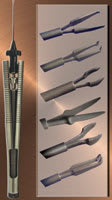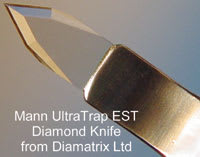disposable instruments
Trends in Disposable Instruments
They gain converts in vitreoretinal, but diamond knives
still rule cataract surgery.
BY JERRY HELZNER, SENIOR EDITOR
While disposable instruments, such as stainless steel knives, have long been used in ophthalmic procedures, the adoption of 25-gauge vitrectomy in recent years has driven strong surgeon demand for disposable vitreoretinal instruments.
This demand came about as more and more surgeons recognized that the smaller, fragile, more flexible and difficult-to-clean instruments used in 25-gauge procedures could often be more cost-effective when purchased in a disposable form costing about $100 to $120 an instrument, as compared to $1,200 to $2,000 for a reusable version of the same instrument. Using high-quality disposable instruments also eliminates the possibility of cross-contamination and ends the need for costly repairs to expensive instruments.
This article will discuss the stunning growth in disposable vitreoretinal instruments, as well as trends in surgical knives and other disposable and "resposable" ophthalmic products.
|
|
|
This disposable end-grasping forceps is from Alcon's Grieshaber Revolution DSP line. Alcon will be introducing reusable handles and disposable tips in November. |
Vitreoretinal Sales Are Booming
An indication of the strong demand for disposable vitreoretinal instruments comes from Merlin Hall, surgical product manager, Alcon (Fort Worth, Texas). Hall reports that sales of these products, primarily consisting of Alcon's Grieshaber Revolution DSP line of different types of forceps and scissors, doubled in 2005 and are on track to double again in 2006.
Given this growth, it is no surprise that Alcon will be introducing a number of additional vitreoretinal disposables at the American Academy of Ophthalmology (AAO) meeting in November. Among the innovations will be intraocular forceps and scissors that combine a disposable tip with a reusable handle.
"We'll be offering three distinct handle designs that surgeons will be able to choose from based on their personal preference and comfort," says Hall.
Alcon will also launch one-piece disposable backflush instruments in both blunt- and soft-tipped versions, a new MVR (microvitreoretinal) blade and a 25-gauge soft-tipped cannula with a green silicone tip for better visualization.
|
|
|
D.O.R.C. manufactures a broad line of disposable instruments for the vitreoretinal surgeon. |
Scott Hamor, sales and marketing director for Dutch Ophthalmic USA (Kingston, N.H.), says he is seeing "phenomenal growth" in his company's line of disposable vitreoretinal instruments.
"The Dutch Ophthalmic Research Center (D.O.R.C.) has been a pioneer in disposable instruments for retina procedures," says Hamor. "We were the first company to provide disposable vitreoretinal forceps and scissors, as well as backflush needles and vitrectomy lenses. We were also the first company to introduce 23-gauge surgery as a popular alternative to 20- or 25-gauge and provide the appropriate disposable instrumentation."
One Company's Strategy
Hamor says that Dutch Ophthalmic's strategy is to offer a broad range of instruments in both disposable and reusable forms for 20-, 23- and 25-gauge surgery.
"We spend a great deal of time talking to surgeons about the types of procedures they perform, their volume and also the surgical setting," says Hamor. "So for a high-volume procedure, like a macular pucker, we may recommend a reusable instrument. For a procedure that the surgeon may perform infrequently, a disposable instrument may be more cost-effective. In this way, we are able to tailor a portfolio of disposable and reusable instruments that best fit surgeons' practice patterns and also makes financial sense."
|
|
|
Synergetics offers a range of vitreoretinal instruments with reusable handles and disposable tips, such as those shown here. |
Dutch Ophthalmic does not offer disposable tips and reusable handpieces.
"We believe we can create a more precision instrument in a single-piece construction," asserts Hamor.
The other player in disposable vitreoretinal instruments is Synergetics (St. Charles, Mo.), which was the first company to introduce disposable tips. Synergetics also offers a unique conversion sleeve that allows a 25-gauge tip to be converted into a 23- or 20-gauge tip.
Synergetics offers a broad product line under the Syntrifugal brand name that encompasses 20- 23- and 25-gauge instruments. The company's Diamond Dusted Membrane Scrapers and laser probes have a loyal following among retina specialists.
"We have seen approximately a doubling of sales in the disposable product line in the past year," says Jason Stroisch, vice president, sales and marketing, ophthalmology. "We use the same technology in making our disposables as we do with our reusable instruments. The disposables may not be as finely polished, but they are equally functional."
Synergetics will soon be expanding its disposable product line with a new horizontal scissors and additional types of forceps.
"The market for disposable instruments will continue to grow because of the increase in procedures that we'll be seeing with an aging population and because the majority of retina specialists are still doing 20-gauge procedures with reusable instruments," says Stroisch. "We are going to these doctors and pointing out the advantages of having an inexpensive disposable instrument as a back-up in case their reusable instrument is not available for the procedure. We just need these doctors to try our disposable instruments and recognize their high quality."
"Resposables" Find their Niche
|
|
|
The advent of multifocal IOLs has driven sales of diamond LRI knives, such as this one from Accutome. |
Over the past few years, Rhein Medical (Tampa, Fla.) has been developing a new category of instruments that it calls "resposables." Initially, Rhein's resposables consisted of a range of specialized instruments with replaceable tips. Most of these instruments were developed by surgeons seeking a better way to perform procedures or deal with problems that can occur during surgery.
An example is the Sabet Lenticular Safety Net, which Rhein developed with Sina J. Sabet, M.D., of Alexandria, Va. This instrument is designed to support and hold a dropping lens to safely allow anterior vitrectomy and phacoemulsification to continue. The net can support several fragments simultaneously. The net itself can be detached and discarded while the handle is designed to be reused.
"The Sabet Safety Net has become a very popular product with surgeons," notes John Bee, president of Rhein Medical.
More recently, Rhein launched an entire line of relatively inexpensive resposable instruments called Eco's (short for "economy"). This broad range of instruments includes several types of forceps, needle holders, scissors, choppers, speculums, dilators and rotators, generally priced at about 10% of the cost of a reusable instrument of the same type.
"More and more surgery centers and hospitals are seeking disposables to reduce the possibility of cross-contamination and endophthalmitis," notes Bee.
Though the Eco's are labeled single-use, some ambulatory surgery centers will reuse them. Made of stainless steel, they are made to withstand hundreds of autoclave cycles. Eco's now also come with "non-sterile" labeling, packaged six per box. The non-sterile labeling will allow re-use of the instruments in hospital-based procedures.
|
|
|
The popular Mann Ultra Trap diamond knife from Diamatrix. |
Trends Favor Diamond Knives
One product segment where the trend toward disposables is not taking hold is surgical knives, where the increasing adoption of small-incision surgery is causing many surgeons to opt for the cleaner cut provided by diamond blades. In addition, the makers of diamond blades have been proactive in educating surgeons in the proper care and cleaning of diamond blades.
"Part of the resurgence we're seeing in diamond blades has been driven by our new blade-cleaning system, which helps keep the delicate cutting edge from being damaged," says Bee. "Though the initial cost of the diamond blade is much higher, it can be the economic choice if cared for correctly."
Diamond blades can range in price from $1,000 to more than $3,000, while the average price of a stainless steel blade can be $20 to $25.
Jim O'Connor, marketing manager for Accutome (Malvern, Pa.), points out yet another factor that is driving the adoption of diamond blades.
"With more and more cataract surgeons now implanting the new multifocal and accommodative lenses under patient-shared billing, they know that patient expectations are high. Surgeons are now buying diamond knives to perform limbal relaxing incisions (LRIs). For many surgeons, the LRI knife is their first experience with a diamond blade and it may lead them to purchase additional diamond blades in the future."
Tom Mancuso, COO of Diamatrix (The Woodlands, Texas), provides a slightly different perspective on the battle of the blades.
"This year, our stainless steel blades are accounting for more than half of our sales," says Mancuso. "I believe that's been due to the quality improvements that we've been able to make in the steel blades. These blades are very consistent and sharp and have closed the quality gap between traditional stainless blades and diamond knives. However, I do anticipate more of a shift to diamond blades in a year or so as more and more surgeons make the move to sub-2.5 mm incisions and find themselves needing to invest in a new set of diamond knives."
Mancuso says Diamatrix is also seeing increased interest in diamond LRI knives, which are among the least expensive of the diamond blades at about $450 to $500 each.
"Diamond knives are preferable to stainless steel for LRIs because they are significantly more cost-effective and much more precise than fixed-depth stainless steel knives. In addition, diamond knives give surgeons the ability to pre-set the blade depth at any setting they wish, not being limited to the few choices stainless steel blades offer," notes Mancuso. "LRI blades are certainly a good entry into diamonds and will help surgeons and staff learn to care for and clean diamond knives. The LRIs allow surgeons to get their feet wet in diamonds with blades that are less expensive."
More Choices Coming
Notwithstanding the increased interest in diamond blades, overall advances in technology are now enabling manufacturers to deliver high-quality precision instruments in a cost-effective disposable form. Though vitreoretinal instruments have been in the forefront in this trend, it is expected that manufacturers will soon turn their attention to producing a wide range of anterior segment instruments in a disposable or resposable form. This will provide surgeons with an even wider range of instrument choices at various price points.













